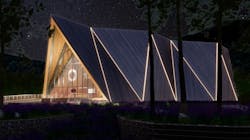Oklo, Southern Ohio Biz Group partnering to develop Advanced Nuclear Reactor plants
California-based small nuclear reactor designer Oklo, with some federal approvals already in its collective pocket, has signed a deal to locate two future power plants in southern Ohio.
The agreement with the Southern Ohio Diversification Initiative (SODI) would allow Oklo to build two advanced small fission reactor plants in the region to create new jobs and, ultimately, carbon-free electric power if the projects are realized to completion and operation. Oklo previously gained U.S. Nuclear Regulatory Commission and Department of Energy approvals for various parts of its technology, but would still need to sign off on this Ohio project.
The DOE also had earlier awarded $61 million to Oklo, the Argonne National Laboratory, Deep Isolation and Case Western Reserve University for a partnership focused on recycling used nuclear fuel into advanced reactor fuel.
Oklo previously detailed a plan to develop commercial nuclear plant deployment with the Idaho National Lab.
The two planned small, advanced reactor units in southern Ohio would provide about 30 MW of carbon-free electricity each at capacity, as well as 50 MW of carbon-free heating. SODI is also a partner in the Site Recuse Deployment Guidance for Advanced Reactors.
The application to the U.S. NRC to approve the projects could be submitted by 2025, the parties say.
“Our business model, and use of mature, demonstrated reactor technologies allow us to provide power to customers who want the reliable, clean, and affordable energy we can provide,” Jacob DeWitte, co-founder and CEO of Oklo, said in a statement about the Ohio partnership.
Oklo, which began working to certify its technologies about seven years ago, reportedly has performed successful prototypic fuel fabrication and received an acceptance from the NRC on its advanced fission combined license application.
In U.S. and beyond, some decarbonization advocates are pursuing advanced and small modular reactor technologies. Utility-scale nuclear energy is carbon-free yet almost prohibitively expensive to build, so some developers are looking at SMR projects with smaller footprints and planned costs.
The press release did not list the specific site for the planned nuclear plants, but other reports indicate they could be located near Piketon, a village near the Portsmouth plant that once produced enriched uranium.
Other designers and companies focused in the SMR nuclear sector include NuScale Power, X-Energy, GE-Hitachi Nuclear and TerraPower. Rolls-Royce, Westinghouse, Rosatom (Russia) and HolTec International are some of the others working on potential SMR reactors for the future.
X-energy and chemicals firm Dow have announced an agreement to locate a small modular reactor plant at Dow's UCC Seadrift operations along the Texas Gulf Coast.
Nuclear power plants currently generate close to 20 percent of the U.S. electricity mix and more than half of the carbon-free power.
About the Author
Rod Walton, EnergyTech Managing Editor
Managing Editor
For EnergyTech editorial inquiries, please contact Managing Editor Rod Walton at [email protected].
Rod Walton has spent 17 years covering the energy industry as a newspaper and trade journalist. He formerly was energy writer and business editor at the Tulsa World. Later, he spent six years covering the electricity power sector for Pennwell and Clarion Events. He joined Endeavor and EnergyTech in November 2021.
Walton earned his Bachelors degree in journalism from the University of Oklahoma. His career stops include the Moore American, Bartlesville Examiner-Enterprise, Wagoner Tribune and Tulsa World.
EnergyTech is focused on the mission critical and large-scale energy users and their sustainability and resiliency goals. These include the commercial and industrial sectors, as well as the military, universities, data centers and microgrids. The C&I sectors together account for close to 30 percent of greenhouse gas emissions in the U.S.
He was named Managing Editor for Microgrid Knowledge and EnergyTech starting July 1, 2023
Many large-scale energy users such as Fortune 500 companies, and mission-critical users such as military bases, universities, healthcare facilities, public safety and data centers, shifting their energy priorities to reach net-zero carbon goals within the coming decades. These include plans for renewable energy power purchase agreements, but also on-site resiliency projects such as microgrids, combined heat and power, rooftop solar, energy storage, digitalization and building efficiency upgrades.

